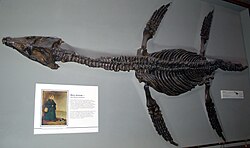Rhomaleosaurus thorntoni
|
Rhomaleosaurus Temporal range: Early Jurassic, Toarcian |
|
|---|---|
 |
|
| Cast of the R. cramptoni holotype specimen, Natural History Museum, London | |
| Scientific classification | |
| Kingdom: | Animalia |
| Phylum: | Chordata |
| Class: | Reptilia |
| Superorder: | †Sauropterygia |
| Order: | †Plesiosauria |
| Family: | †Rhomaleosauridae |
| Genus: |
†Rhomaleosaurus Seeley, 1874 |
| Species | |
|
|
Rhomaleosaurus (meaning "strong lizard") is an extinct genus of Early Jurassic (Toarcian age, about 183 to 175.6 million years ago) rhomaleosaurid pliosauroid known from Northamptonshire and from Yorkshire of the United Kingdom. It was first named by Harry Seeley in 1874 and the type species is Rhomaleosaurus cramptoni. It was one of the earliest large marine reptile predators which hunted in the seas of Mesozoic era. Its length was about 7 m (23 ft) long. Like other pliosaurs, Rhomaleosaurus fed on ichthyosaurs, ammonites and other plesiosaurs.
In July 1848, a fossil of a large plesiosaur was unearthed in an Alum quarry at Kettleness, near Whitby, in Yorkshire, England. It was collected from the A. bifrons ammonite zone of the Whitby Mudstone Formation, dating to the early Toarcian age, about 183 to 180 million years ago. The complete skeleton which preserved the skull, NMING F8785, was kept for five years at Mulgrave Castle, which was then owned by the Marquess of Normanby. In 1853, the Marquess introduced the interesting finding to the eminent Irish surgeon and anatomist, Sir Philip Crampton. The same year, Crampton transferred the fossil to Dublin to be displayed as a centrepiece at the 1853 British Association annual meeting. The Zoological Society of Ireland built a specially constructed building to house the large reptile. After a decade, still remaining undescribed, the specimen moved in the Royal Dublin Society museum and officially described by Alexander Carte and W. H. Bailey as a new species of Plesiosaurus. Carte and Bailey named the species Plesiosaurus cramptoni after the Irish scientist, Sir Philip Crampton. In 1874, the British geologist Harry G. Seeley, based on this finding, which is now known as the holotype of the family Rhomaleosauridae, recognized and erected a new genus establishing Rhomaleosaurus. Only in 2006 the skull of this specimen was finally prepared and enabled a restudy of this genus.
...
Wikipedia
